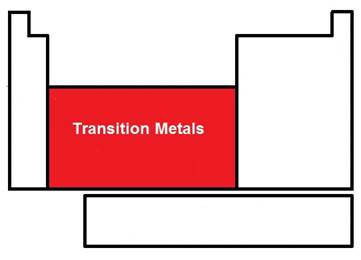Transition Metals
Transition metals are a group of elements on the periodic table located in the middle or group B section. This placement coincides with elements which have their d-orbitals being filled by electrons. Because of the nature of the d-orbitals, and the stability of empty, half-filled, and completely filled orbitals, transition metals often have more than one oxidation state. Iron, for example, can lose 2, 3 or 6 electrons depending on the reaction to create oxidation states of +2, +3 or +6.

Transition metals have an array of physical properties:

Transition metals have an array of physical properties:
- They are most often found in minerals.
- Most transition metals will produce compounds that have a vibrant color including colors that vary with the varying oxidation states.
- Many transition metals are magnetic.
- Many transition metals can form complex ions.
|
Related Links: Chemistry Transition Metals Chelating Agents Coordination Compounds Naming Coordination Compounds |
To link to this Transition Metals page, copy the following code to your site:
